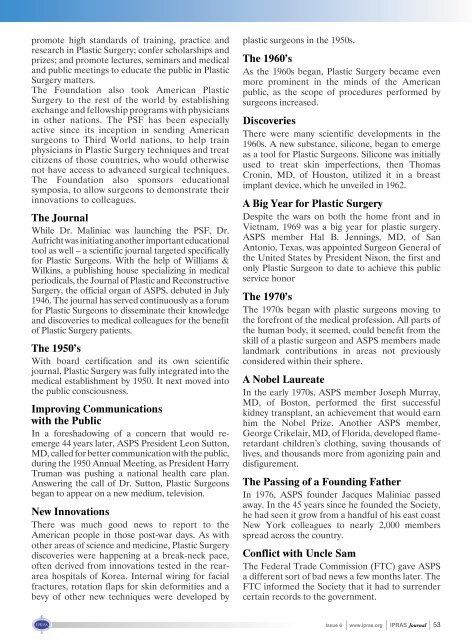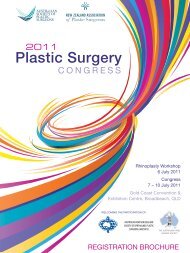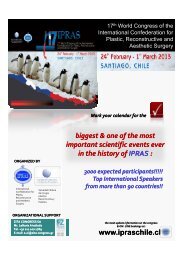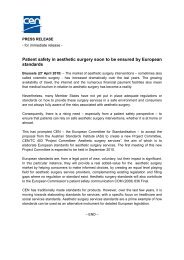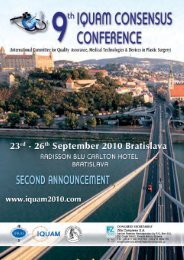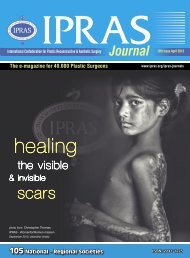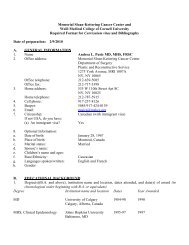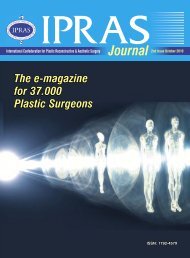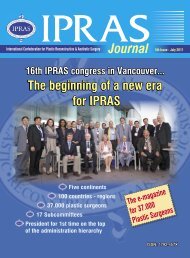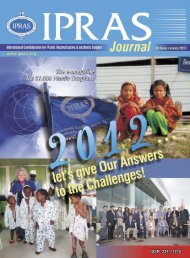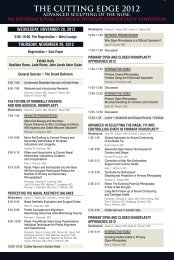Download pdf file - IPRAS
Download pdf file - IPRAS
Download pdf file - IPRAS
- No tags were found...
Create successful ePaper yourself
Turn your PDF publications into a flip-book with our unique Google optimized e-Paper software.
promote high standards of training, practice andresearch in Plastic Surgery; confer scholarships andprizes; and promote lectures, seminars and medicaland public meetings to educate the public in PlasticSurgery matters.The Foundation also took American PlasticSurgery to the rest of the world by establishingexchange and fellowship programs with physiciansin other nations. The PSF has been especiallyactive since its inception in sending Americansurgeons to Third World nations, to help trainphysicians in Plastic Surgery techniques and treatcitizens of those countries, who would otherwisenot have access to advanced surgical techniques.The Foundation also sponsors educationalsymposia, to allow surgeons to demonstrate theirinnovations to colleagues.The JournalWhile Dr. Maliniac was launching the PSF, Dr.Aufricht was initiating another important educationaltool as well – a scientific journal targeted specificallyfor Plastic Surgeons. With the help of Williams &Wilkins, a publishing house specializing in medicalperiodicals, the Journal of Plastic and ReconstructiveSurgery, the official organ of ASPS, debuted in July1946. The journal has served continuously as a forumfor Plastic Surgeons to disseminate their knowledgeand discoveries to medical colleagues for the benefitof Plastic Surgery patients.The 1950’sWith board certification and its own scientificjournal, Plastic Surgery was fully integrated into themedical establishment by 1950. It next moved intothe public consciousness.Improving Communicationswith the PublicIn a foreshadowing of a concern that would reemerge44 years later, ASPS President Leon Sutton,MD, called for better communication with the public,during the 1950 Annual Meeting, as President HarryTruman was pushing a national health care plan.Answering the call of Dr. Sutton, Plastic Surgeonsbegan to appear on a new medium, television.New InnovationsThere was much good news to report to theAmerican people in those post-war days. As withother areas of science and medicine, Plastic Surgerydiscoveries were happening at a break-neck pace,often derived from innovations tested in the rearareahospitals of Korea. Internal wiring for facialfractures, rotation flaps for skin deformities and abevy of other new techniques were developed byplastic surgeons in the 1950s.The 1960’sAs the 1960s began, Plastic Surgery became evenmore prominent in the minds of the Americanpublic, as the scope of procedures performed bysurgeons increased.DiscoveriesThere were many scientific developments in the1960s. A new substance, silicone, began to emergeas a tool for Plastic Surgeons. Silicone was initiallyused to treat skin imperfections, then ThomasCronin, MD, of Houston, utilized it in a breastimplant device, which he unveiled in 1962.A Big Year for Plastic SurgeryDespite the wars on both the home front and inVietnam, 1969 was a big year for plastic surgery.ASPS member Hal B. Jennings, MD, of SanAntonio, Texas, was appointed Surgeon General ofthe United States by President Nixon, the first andonly Plastic Surgeon to date to achieve this publicservice honorThe 1970’sThe 1970s began with plastic surgeons moving tothe forefront of the medical profession. All parts ofthe human body, it seemed, could benefit from theskill of a plastic surgeon and ASPS members madelandmark contributions in areas not previouslyconsidered within their sphere.A Nobel LaureateIn the early 1970s, ASPS member Joseph Murray,MD, of Boston, performed the first successfulkidney transplant, an achievement that would earnhim the Nobel Prize. Another ASPS member,George Crikelair, MD, of Florida, developed flameretardantchildren’s clothing, saving thousands oflives, and thousands more from agonizing pain anddisfigurement.The Passing of a Founding FatherIn 1976, ASPS founder Jacques Maliniac passedaway. In the 45 years since he founded the Society,he had seen it grow from a handful of his east coastNew York colleagues to nearly 2,000 membersspread across the country.Conflict with Uncle SamThe Federal Trade Commission (FTC) gave ASPSa different sort of bad news a few months later. TheFTC informed the Society that it had to surrendercertain records to the government.Issue 6 www.ipras.org <strong>IPRAS</strong> Journal 53


